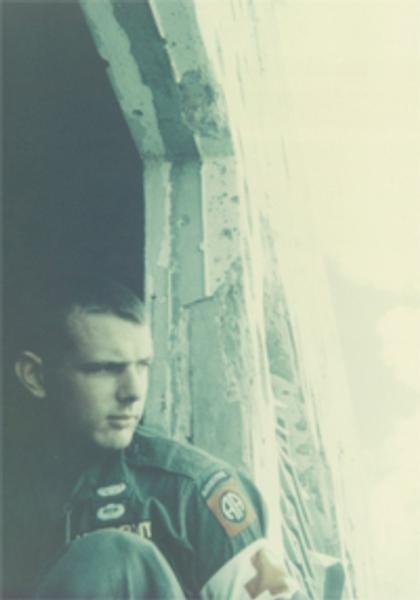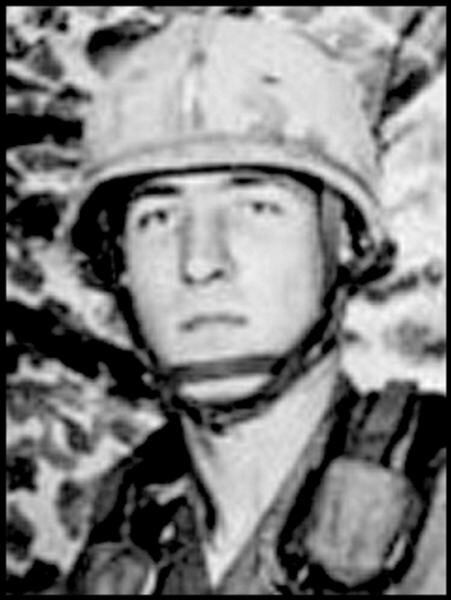The Vietnam Veterans Memorial includes more than 58,000 names of men and women killed or missing in action during the Vietnam War. Together these names comprise one of the most powerful war memorials in the world. Posted below are just a few stories of the fallen, as written by their loved ones. These first-person accounts are included in "Dreams Unfulfilled," a collection published in 2010 by the Vietnam Veterans Memorial Fund.
Military Times has partnered with VVMF in its mission to find photos of every single casualty listed on The Wall. With fewer than 9,000 to go before the collection reaches its goal, you can help us #FinishTheWall. Learn more here.
By Yolanda Acevedo
As we went through the base gates, there was a soldier there. At that moment, I realized that they were always there, a familiar and constant feature in my childhood universe. We went to Dad's office and said hello to different people. Most I recognized; some I did not.

Cpl. Jose L. Montes, U.S. Army
Photo Credit: Vietnam Veterans Memorial Fund
Many had been to our house on different occasions—for parties, to say hello or just to talk. It was 1968, and we were in the middle of the Vietnam War. I guess that during difficult times and being far away from home, friends became family. I remember back then, we had a lot of family!
It was a beautiful spring day in paradise. After lunch, Dad and I played golf. I had never played golf before that day. I think that, like many things in life, golf is something that you either like or you don't. I do not like golf. I never have.
That day, however, it was different. That day, I loved golf. It was our special day, and for a little girl who adored her father, it was heaven. Dad tried to teach me to play the game he loved, and I loved every minute of it. We talked, walked and laughed all through the golf course while trying unsuccessfully to play. We shared stories and dreams all day long.
It was the perfect day, just my best friend and me. As time passes by, some memories start to fade, while others remain. I have many memories of Dad, but the images and feelings of that day will stay with me forever.
Years later, I learned that Dad had received deployment orders just a week before our little outing. He was going to Vietnam. He was going to leave me behind. Soon after, he was gone! I was alone and, for the first time, I experienced loneliness. There would be no more breakfasts together, no more playing golf or singing, and no more walks for Dad and me. He left, never to come back.
Among the personal items returned to us by the Army were pieces of Dad's rosary. He always wore it around his neck. Years later, I decided to put together the remaining pieces. On my wedding day, I hid it in my bouquet. No one knew.
We were deprived of so many days, but not that day. In a very simple and quiet way, he walked down the aisle with me.
We had one more walk together, Dad and me.
Jose L. Montes is honored on Panel 41W, Row 25 of the Vietnam Veterans Memorial.
YOLANDA ACEVEDO lives in Virginia with her two children. She lost her husband, Navy Commander Joseph Acevedo, in Bahrain in 2003 during Operation Iraqi Freedom. She serves as a peer mentor for the Tragedy Assistance Program for Survivors (TAPS), a national non-profit organization that provides services to those who have lost a loved one on active duty in the armed forces. She is also a member of Sons and Daughters in Touch (SDIT), a group of children of the men whose names are on The Wall, and spoke at the Father's Day Rose Remembrance Ceremony at The Wall in 2006.
Living Life to the Fullest
By Judy C. Campbell
Live, laugh, love. When I think of my brother Keith Allen Campbell, I think of those three words. Keith was the epitome of someone who lived life to its fullest.
Sadly, he left this earth on Feb. 8, 1967, while serving in the U.S. Army in Vietnam with the 173d Airborne Brigade (Sep.). An Army medic, he used his body as a shield to protect a fellow soldier after he had provided life-saving medical treatment. Keith had already served in the Dominican Republic with the 82nd Airborne Division and had received his Honorable Discharge. But he re-enlisted as the Vietnam conflict heated up, because, he said, "My medic skills are needed."
Long before he was an Army medic, he was my big brother. I vividly remember playing with my Barbie and Ginny dolls, taking a blanket and cardboard to partition off rooms as if I were making my own little dollhouse. Often, I was teased for this—playing with dolls long after many of my girlfriends became interested in boys—but Keith never teased me. Instead, he often made splints for my dolls, as I pretended they fell and broke a leg or arm.
Keith always wanted to become an Army doctor, and I wanted to become a nurse; we shared a common bond in this field. His Boy Scout troop #165 at Mt. Olivet Church in Arlington, Va., always won the first aid competitions because of Keith's efforts. In addition to giving medical treatment to my dolls, he also helped patch up the local kids as he got older. I was always his ready and willing nurse, no matter who the patients were!

SP4 Keith Allen Campbell, U.S. Army
Photo Credit: Vietnam Veterans Memorial Fund
Our mother, Esther B. Campbell Gates, saw Keith's interest in medicine early on and invested in a set of medical encyclopedias, which Keith read cover to cover several times. Later, when my children were growing up, I would often reference these books.
Over the years, Keith caught me opening my Christmas presents early, then rewrapping them so no one would know I had been peeking. I just could not wait for Christmas morning! Over the years, he liked trying to frustrate my attempts at getting a preview of my gifts—for instance, taking an entire roll of Scotch tape to wrap my gift.
But, I will never forget Christmas 1961; I think Keith was more excited than I was! Our front hallway door was always open, so it was not unusual for it to be open that Christmas morning. But for some reason, Keith kept an eye on it, making sure nobody closed it. We began taking turns opening our gifts, and when it was my turn, Keith said, "Judy, go close the hallway door."
When I did, there behind the door was a life-sized doll for me! She was the size of a three-year-old child. I still have "Peggy," as we named her, and now my granddaughters play with her.
Keith was not only my big brother, but he was also a father figure, someone I truly looked up to for advice. I was amazed at how many people loved and respected him. He was adventuresome, but not reckless or careless. School bored Keith, as he was a hands-on type of guy and in many ways was self-educated.
Being a medic in the Army was just the first step in my brother's life plan, in which he eventually saw himself becoming a doctor. While he never was able to complete all he wanted to do, he did use his medical skills to help many people before he died. While on maneuvers with the 11th Special Forces, his first sergeant walked into a tree limb. Keith immediately knew that time was of the utmost importance and surgically removed the limb, saving his vision. Sgt. Wood remains in contact with our family to this day.
SP4 Keith Allen Campbell gave his all during his life, and his memory will live on for generations to come. In my heart, I will always be honored to say that not only did I know Keith Allen Campbell, but I was blessed to be his baby sister.
Keith Allen Campbell is honored on Panel 15E, Row 8 of the Vietnam Veterans Memorial.
JUDY C. CAMPBELL lives in Wilmington, Del., and is an active participant in VVMF ceremonies and programs, as well as a strong supporter of the Education Center at The Wall. She works tirelessly on behalf of Gold Star Families everywhere. Keith A. Campbell's memory lives on in many ways. In 2006, the Fort Sam Houston Library was renamed the Keith A. Campbell Memorial Library. Also, the George Washington Chapter of the Association of the U.S. Army issues the Keith A. Campbell Memorial Plaque annually to the outstanding enlisted reservist in the Washington, D.C. area.
An American Hero
By Army Gen. Barry R. McCaffrey (ret.)
1st Lt. David Ragin was my brother-in-law and my hero. He was killed in action on Aug. 24, 1964 in a bloody battle along with three other brave American advisors serving with the Vietnamese 41st Ranger Battalion in Kien Hoa Province, 45 miles southwest of Saigon. The Rangers suffered more than 200 casualties during this violent ambush.
All four received the Distinguished Service Cross, the nation's second-highest award for valor. In addition to Dave, the advisors included Capt. Byron Clark Stone, Capt. James Michael Coyle and Sgt. 1st Class Tom Ward.
Dave received the Distinguished Service Cross for his actions during this terrible one-hour and 40-minute battle, in which the Viet Cong conducted four major assaults on the Ranger positions. With aggressive courage during the firefight, he killed more than 30 enemy soldiers. He was last seen alive firing a machine gun while covering the withdrawal of his unit. Dave was 25 when he died in the service of his country. He was promoted to captain after his death.
No one was surprised at Dave's courageous death. He was a senior-ranking cadet at The Citadel, class of 1961. He graduated from Palatka (Florida) High School in 1957 as a very popular and respected student who was a superb athlete and the captain of the football team. The National Guard Armory was named in his honor after his death.
Dave married my sister in 1961 following his graduation from The Citadel. He completed Ranger School and Airborne School at Ft. Benning, Ga. Dave then served with great distinction as an infantry officer in the 101st Airborne Division at Ft. Campbell, Ky. He was given early command of a company and named best company commander in the division prior to volunteering for Vietnam duty.
Dave and my sister had two daughters. Beth has become an accomplished business woman. Daughter Lisa Ann, whom he never saw, died 55 days after Dave was killed and was buried in his arms at Arlington National Cemetery. The officer who escorted Dave's body home from combat was his dear friend and high school classmate, Capt. Henry A. Deutsch. Henry returned to combat in Vietnam and was subsequently killed in action on May 11, 1965.

Army Capt. William David Howsa Ragin
Photo Credit: Vietnam Veterans Memorial Fund
When Dave was killed, there had only been 189 other Americans KIA in the Republic of Vietnam. The loss of the entire advisory team to 41st Ranger Battalion was a great shock to the country and widely covered in the press at the time. By 1968, we were suffering more than 1,200 killed in action each month. By the end of the war, more than 58,000 brave service men and women had perished in Vietnam, and 304,000 were wounded during this longest American war.
Shortly before Dave deployed, he and I spent half the night talking. I was a cadet at West Point and had enormous respect for this dedicated and confident young officer. Dave was filled with enthusiasm and spirit. His dad had fought in World War II, and he wanted to join the long line of American patriots who had served to keep us free. His promising life was cut so short. All of us who knew and served with him are better because of his example of integrity, service and courage.
The caption under David Ragin's picture in his high school yearbook is his enduring epitaph: "He is so good that no one can be a better man."
William David Howsa Ragin is honored on Panel 1E, Row 62 of the Vietnam Veterans Memorial.
GEN. BARRY McCAFFREY, USA (Ret.) served 32 years of active military duty with four combat tours, including advisory duty with the Army of the Republic of Vietnam from 1966–67 and company command with the 1st Cavalry Division in Vietnam from 1968-69. He was twice awarded the Distinguished Service Cross, received two Silver Star medals and was awarded three Purple Heart medals for wounds received in infantry combat. Gen. McCaffrey is a member of VVMF's Corporate Council and is the chairman of the Advisory Board for the Education Center at The Wall. In January 2010, he chaired a delegation of veterans and their families who returned to Vietnam to observe the operations of VVMF's international humanitarian program there, Project RENEW.
Unless they were so woozy they couldn't stand up, we would get the blood samples we needed for diagnosis, let them shower, feed them and then let them sleep as much as possible around monitoring their temperatures and getting additional malaria smears. Most of them weren't too sick—sick enough to be sent to the hospital, but not critical.
After diagnosis and treatment, they sometimes went straight back to the field, or if they were lucky, they got a week or so at the 6th Convalescent Center in Cam Rahn Bay. That's probably why I don't remember names. I didn't want to pick up a Stars and Stripes and see that someone we had sent back to the field had gotten killed.
One afternoon, a call came from the ER: FUO, unconscious, temperature off the end of the thermometer. They did not have much history on the patient. He was out in the boonies with his unit and hadn't felt good for a couple of days, but nothing specific. Then suddenly he collapsed, burning up to the touch. They threw him in a mud puddle to try to get his temperature down and called in a "dust off" (the helicopter that would take him to the hospital).
They brought him up from the ER on a stretcher, packed in bags of ice. We got all the diagnostic tests, got another IV in him and a urinary catheter. Jim, our chief of medicine, was the doc. We started him on quinine in case he had malaria. We gave him something for typhus and something else for a bacterial infection. None of the tests showed anything in particular. We kept sponging him down and, between that and the aspirin suppositories, his temperature started coming down.
A little before 7 p.m., the night nurse and corpsman came in and saw what was going on. I asked the nurse to handle the rest of the ward. I hadn't done any 6:00 meds, but one of the corpsmen had done vital signs, kept an eye on the IVs, gotten everyone fed and had told me everyone else was OK. All the other patients knew what was going on.
Finally, we had done everything we could. His temperature had come down, and we had gotten him cleaned up. I gave a report to the night nurse and then went back in the room to see if Jim needed me for anything else before I left. No, he said, but he thought that he would stay for a while.
The next morning when I came back, Jim was still there. He had stayed by this guy's side all night, and he was there almost all that day, too, except for a few breaks. The patient was still unconscious but stable.
We never knew what killed him, whether it was whatever caused his fever or if it was because the fever was so high it "zapped" his brain.
I don't remember his name or where he was from, but I know where he is now. His name is somewhere on the west Wall of the Vietnam Veterans Memorial, panels 26-19. He didn't die alone. And I remember him.

Tony leads a team of more than 30 editors, reporters and videographers dedicated to covering the news that affects service members and their families. Tony is responsible for strategy of the Military Times digital brands, the print publications, video and multimedia projects for Army Times, Navy Times, Air Force Times and Marine Corps Times.




